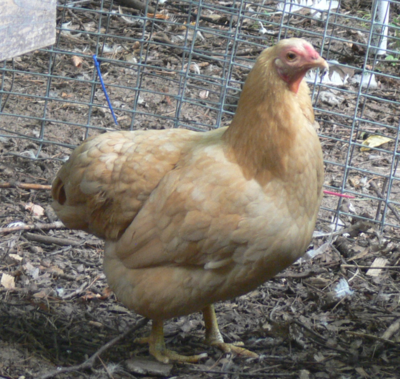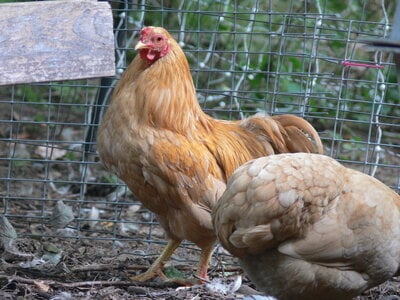My gut reaction to the images was "pullet". I'm not seeing any sex feathering or wattle development, two of the biggest things I use to determine sex in Chanteclers.Since this is the Chantecler thread, please let me know if this is a male or female. This bird is 13 weeks old. We purchased straight run from Sandhill Preservation (hatched April 29). We only got 1 Chantecler and since they have small wattles and combs, we are not totally sure the gender. There seems to be some elongated tail feathers, so we suspect male, but never had this breed, so we are needing guidance.
All pics are the same bird. View attachment 1865255View attachment 1865256View attachment 1865257View attachment 1865258View attachment 1865259View attachment 1865260
Navigation
Install the app
How to install the app on iOS
Follow along with the video below to see how to install our site as a web app on your home screen.
Note: This feature may not be available in some browsers.
More options
You are using an out of date browser. It may not display this or other websites correctly.
You should upgrade or use an alternative browser.
You should upgrade or use an alternative browser.
Chicken Breed Focus - Chantecler
- Thread starter sumi
- Start date
Six pounds sounds pretty good. I wish I had kept records on my last batch of LF cockerels. There was one that turned out absolutely massive.Weigh- ins tonight, maybe on the light side because of having to hold the birds on the scale. The biggest cockerel at sixteen weeks of age, six pounds. Does this sound good? I've misplaced the records from last year!A couple of them were closer to five pounds body weight, and one boy flared at me (he's not a keeper!!!).
Mary
@Folly's place and @BantyChooks - Thanks for the opinions. You both hit upon the reasons I can't determine if M or F. The tail feathers and the redness of comb/wattles at 13 weeks makes me think male. But the lack of any wattle development, and a pretty flat cushion comb make me think female. I went to my APA book to see if there were any defining traits between M and F for the breed and it isn't helping either! White birds are harder to see feathering differences, but with the Chantecler having such small combs and wattles for either sex, makes it pretty difficult to determine at this age, it seems.
We can take our unwanted birds to an auction tomorrow, so I'm trying to determine who is going. This one might get a reprieve until October (next auction possibility) since we are unsure. Also, it is not causing any troubles with the flock at this point (unlike a few others that will certainly be going to auction) so there should be no problems with keeping this one for now.
We can take our unwanted birds to an auction tomorrow, so I'm trying to determine who is going. This one might get a reprieve until October (next auction possibility) since we are unsure. Also, it is not causing any troubles with the flock at this point (unlike a few others that will certainly be going to auction) so there should be no problems with keeping this one for now.
I'm trying to sort mine out too! My extra cockerels will probably go to the freezer, but they are still too small. There's a weekly auction near here, so they could go there instead. Also one pullet, the ONLY pullet who hatched here, who has an 'underbite' rather than a normal beak. Makes me want to move her hatchmate cockerels on too...
Mary
Mary
- Oct 27, 2012
- 812
- 1,925
- 257
I would like to have these if I remain where I am. Then againe, a Canadian cycen would go well (?) with a Byck-eye.
So beautifulThe Chantecler is a dual purpose Canadian breed that was developed starting around 1908 by Brother Wilfred Chatelain, in the agricultural school associated with, Cistercian Abbey in Oka, Quebec. He set out to create a tough and hardy breed that was well suited to the harsh Canadian winters, as well as being a good layer and good meat bird. The breed was introduced to the public in 1918, and became a useful breed for very cold climates. The Chantecler is notable for having a very small cushion comb and almost no wattles, making it very resistant to frostbite. Its temperament is generally calm and quiet, though young birds can be flighty. They are generally very good foragers. The hens are excellent winter layers of large brown eggs, do go broody fairly often and make good mothers. They are considered an excellent table bird.
The Chantecler is one of only two chicken breeds developed in Canada. The name Chantecler was created from the combination of the French ‘chanter,’ “to sing,” and ‘clair,’ “bright”. The original Chantecler developed by Brother Chatelain was a White bird, later Dr. J. E. Wilkinson of Alberta, Canada developed the Partridge color for a bird more suitable for keeping free range. Buff and Red among other colors have also been developed. Breeds were used in the creation of the Chantecler, including Dark Cornish, Cochins, Leghorns, Plymouth Rocks, Rhode Island Reds and Wyandottes.
Commercial breeds replaced the Chantecler over time, and by 1979 the Chantecler was no longer found in the university or commercial hatcheries and in danger of extinction. A number of small flocks persisted, and it has regained popularity in the last ten years or so, and can again be found available in a number of commercial hatcheries.
It was recognized by the APA in 1921 and is on The Livestock Conservancy's Critical list.
Details:
Breed purpose: Duel Purpose, Meat Bird.
Comb Type: Small Cushion comb
Broodiness: Frequent, good mothers.
Climate Tolerance: Good, very cold hardy.
Weight: Rooster 8.5 lbs, Hen 6.5 lbs.
Egg Productivity: Fair-Good, very good winter layer.
Egg Size: Large
Egg Color: Brown
Pic by @TimG
Pic by @TimG
Pic by @Mac22
Pic by @chickenbike
Pic by @chickenbike
BYC Breed reviews:
https://www.backyardchickens.com/products/chantecler
General breed discussions & FAQ thread:
https://www.backyardchickens.com/t/243277/chantecler-thread/0_20
Do you own Chanteclers? Are you a Chantecler breeder? If so, please reply to this thread with the your thoughts and experiences, including:
· What made you decide to get this breed?
· Do you own them for fun? Breeding? Some other purpose?
· What are your favorite characteristics about this breed?
· Post some pics of your birds; male/female, chicks, eggs, etc!
We have a bunch of other awesome breed-focus threads for you to enjoy. You can see all of them here: https://www.backyardchickens.com/threads/chicken-breed-focus-project.975504/
I would have 7 of them in an instant lol
Glad to see this thread on the front page again. Despite a few setbacks and losses, I have had a decent year with my buff chantecler bantams. I am hopeful for next spring's breeding pens.
BC, do you have pictures? I'd love to see your birds!
How is fertility with the bantams? My standards have been running about 50% clears, not good. This year I'm raising some new ones, we'll see how next spring goes. I do wonder if it's all the fluff on their rear ends...
This week is 'weigh in' time, the youngsters are 24 weeks old. Update later.
Mary
How is fertility with the bantams? My standards have been running about 50% clears, not good. This year I'm raising some new ones, we'll see how next spring goes. I do wonder if it's all the fluff on their rear ends...
This week is 'weigh in' time, the youngsters are 24 weeks old. Update later.
Mary
No photographs of them set up nicely, but I have a few of them running around outside. I have two more younger birds in a pen that have not yet been photographed; I'm not liking how the male's comb is turning out, but their type is nicer than the other, older birds, as they are from a different breeding pen.BC, do you have pictures? I'd love to see your birds!
How is fertility with the bantams? My standards have been running about 50% clears, not good. This year I'm raising some new ones, we'll see how next spring goes. I do wonder if it's all the fluff on their rear ends...
This week is 'weigh in' time, the youngsters are 24 weeks old. Update later.
Mary
I think the females' color looks better this generation than the last. Whilst their dam's almost cochin-esque type drowned out a bit of the finer points of their sire, I am overall quite pleased and feel like I have a solid group to work with next year.
These are the parents of the older group. Unfortunately the hen was taken by a fox a few months ago. I quite like the front on the male, he has a weak head and maybe a shade too much leghorn influence yet, but overall I am quite happy with him. He's one of last year's hatches, progeny of the best two birds out of my original trio.


Fertility is decent this year. There seems to be some difficulty with lack of libido, but swapping around the males seemed to help, and after a month or two in the spring I got consistently fertile eggs all summer.
The rose-combed, oversize male is not going to stick around much longer. I like the brilliance of his colour on top, but in addition to his prior-mentioned issues, he has white mottling in his tailfeathers and poor undercolour.
These are slightly old images. In the last few weeks they've matured a lot—I need to get new photos.
Nice! Love the hen and pullets!
Mary
Mary
New posts New threads Active threads
-
Latest threads
-
-
-
-
-
Run screen door
- Started by Witchychickens
- Replies: 1
-
-
Threads with more replies in the last 15 days
-
Checking-In On Peeps - Post Here To Say Hello!
- Started by Nifty-Chicken
- Replies: 623
-
-
-
-
Can I get some help from someone with careless neighbours who own dogs.
- Started by RiDaGeckoGuy
- Replies: 102
-



